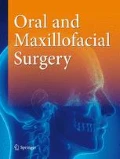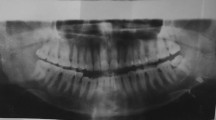Abstract
Purpose
The aim of the present study was to evaluate the outcomes in patients with subcondylar fracture of mandible treated with 2 single miniplates compared to a 3-dimensional (3D) plate.
Patients and methods
This is a retrospective study which included patients diagnosed and treated for mandibular subcondylar fracture from January 2015 to December 2019. Included patients were divided into two groups, group 1: 2 miniplate group and group 2: 3D plate group. The data was obtained from the patients’ records and evaluated for various outcomes including occlusal stability, postoperative complications like plate fracture, non-union, plate or screw loosening, and plate or screw infection leading to implant removal, wound dehiscence, salivary fistula, and facial nerve paralysis. The statistical analysis was performed using chi square test and Student’s t test.
Results
A total 58 patients (43 males and 15 females) were enrolled in the two groups ranging from 21 to 59 years. A total of 35 patients were recruited in group 1, whereas 23 patients were recruited in group 2. There was no statistically significant difference in the two groups with regard to the age range, gender, diagnosis, side of fracture, and accompanying fractures. Occlusal instability, wound dehiscence, and facial nerve paralysis was found in both the groups. Group 1 had 1 patient which required implant removal due to screw loosing, whereas group 2 had 2 patients which required plate removal due to plate fracture. One patient in group 2 required second surgery for fixation of fracture due to non-union. One patient in group 1 developed a sialocele postoperatively. However, there was no statistically significant difference in any of the variables assessed among the two groups (p > 0.05).
Conclusion
The results of our study indicate that the 2 miniplates and 3D plate system are effective in the management of mandibular subcondylar fractures.


Similar content being viewed by others
References
Marker P, Nielsen A, Bastian HL (2000) Fractures of the mandibular condyle. Part 1: patterns of distribution of types and causes of fractures in 348 patients. Br J Oral Maxillofac Surg 38(05):417–421
Asim MA, Ibrahim MW, Javed MU, Zahra R, Qayyum MU (2019) Functional outcomes of open versus closed treatment of unilateral mandibular condylar fractures. J Ayub Med Coll Abbottabad 31(01):67–71
Singh V, Bhagol A, Goel M, Kumar I, Verma A (2010) Outcomes of open versus closed treatment of mandibular subcondylar fractures: a prospective randomized study. J Oral Maxillofac Surg 68(06):1304–1309
Anirudhan A, Khalam SA, Zachariah RK (2013) Evaluation of clinical use of indigenously developed delta plate in management of subcondylar fracture. Clin Pract 3(2):e28. https://doi.org/10.4081/cp.2013.e28
Chaudhary M, Pant H, Singh M, Vashistha A, Kaur G (2015) Evaluation of trapezoidal-shaped 3-D plates for internal fixation of mandibular subcondylar fractures in adults. J Oral Biol Craniofacial Res 5(3):134–139. https://doi.org/10.1016/j.jobcr.2015.07.005
Zide MF, Kent JN (1983) Indications for open reduction of mandibular condyle fractures. J Oral Maxillofac Surg 41(02):89–98
Kanno T, Sukegawa S, Tatsumi H, Karino M, Nariai Y, Nakatani E, Furuki Y, Sekine J (2016b) Does a retromandibular transparotid approach for the open treatment of condylar fractures result in facial nerve injury? J Oral Maxillofac Surg 74:2019–2032
Cortelazzi R, Altacera M, Turco M, Antonicelli V, De Benedittis M (2015) Development and clinical evaluation of MatrixMANDIBLE subcondylar plates system (Synthes). Craniomaxillofac Trauma Reconstr 8:94–99
Valiati R, Ibrahim D (2008) Mer Abreu et al. The treatment of condylar fractures: to open or not to open? A critical review of this controversy. Int J Med Sci 5(6):313–318
Eckelt U, Schneider M, Erasmus F, Gerlach KL, Kuhlisch E, Loukota R, Rasse M, Schubert J, Terheyden H (2006) Open versus closed treatment of fractures of the mandibular condylar processe – a prospective randomized multi-centre study. J Cranio-Maxillofacial Surg 34:306–314
Choi K-Y, Yang J-D, Chung H-Y, Cho B-C (2012) Current concepts in the mandibular condyle fracture management part II: open reduction versus closed reduction. Arch Plast Surg 39(4):301–308
Spinzia A, Patrone R, Belli E, Dell’Aversana Orabona G, Ungari C, Filiaci F, Agrillo A, de Riu G, Meloni SM, Liberatore G, Piombino P (2014) Open reduction and internal fixation of extracapsular mandibular condyle fractures: a long-term clinical and radiological follow-up of 25 patients. BMC Surg 14:68
Choi BH, Yi CK, Yoo JH (2001) Clinical evaluation of 3 types of plate osteosynthesis for fixation of condylar neck fractures. J Oral Maxillofac Surg 59:734–737
Parascandolo S, Spinzia A, Parascandolo S, Piombino P, Califano L (2010) Two load sharing plates fixation in mandibular condylar fractures: biomechanical basis. J Craniomaxillofac Surg 38(5):385–390
Costa FW, Bezerra MF, Ribeiro TR, Pouchain EC (2012) VdeP Saboia, Soares ECS Biomechanical analysis of titanium plate systems in mandibular condyle fractures: a systematized literature review. Acta Cir Bras 27(6):424–429
Wilson AW, Ethunandan M, Brennan PA (2005) Transmasseteric antero-parotid approach for open reduction and internal fixation of condylar fractures. Br J Oral Maxillofac Surg 43:57–60
Kanno T, Sukegawa S, Fujioka M, Takabatake K, Furuki Y (2011) Transoral open reduction with rigid internal fixation for subcondylar fractures of the mandible using a small angulated screwdriver system: is endoscopic assistance necessary? J Oral Maxillofac Surg 69:e372–e384
Pereira-Filho V, Welsh B, Schübel F, Landes C, Sader R, Gabrielli M, Monnazzi M (2011) Intraoral approach for treatment of displaced condylar fractures: case report. Cranio- maxillofac Trauma Reconstr 4:107–112
Arcuri F, Brucoli M, Baragiotta N, Benech R, Ferrero S, Benech A (2012) Analysis of complications following endoscopically assisted treatment of mandibular condylar fractures. J Craniofac Surg 23:e196–e198
Meyer C, Zink S, Chatelain B, Wilk A (2008) Clinical experience with osteosynthesis of subcondylar fractures of the mandible using TCP plates. J Craniomaxillofac Surg 36:260–268
Hou J, Chen L, Wang T, Jing W, Tang W, Long J, Tian W, Liu L (2014) A new surgical approach to treat medial or low condylar fractures: the minor parotid anterior approach. Oral Surg Oral Med Oral Pathol Oral Radiol 117:283–288
Sikora M, Olszowski T, Sielski M, Stąpor A, Janiszewska-Olszowska J, Chlubek D (2015) The use of the transparotid approach for surgical treatment of condylar fractures - own experience. J Craniomaxillofac Surg 43:1961–1965
Ahuja SA, Galinde J, Asnani U, Mistry YA (2018) Comparative evaluation of clinical out- comes using delta plates and conventional miniplates for internal fixation of mandibular condylar fractures in adults. J Oral Maxillofac Surg 76:1255–1266
Sukegawa S, Kanno T, Masui M, Sukegawa-Takahashi Y, Kishimoto T, Sato A, Furuki Y (2019) Which fixation methods are better between three-dimensional anatomical plate and two miniplates for the mandibular subcondylar fracture open treatment? Journal of Cranio-Maxillo-Facial Surgery 47:771–777
Author information
Authors and Affiliations
Corresponding author
Ethics declarations
Conflict of interest
The authors declare that they have no conflict of interest.
Ethical approval
Not required
Additional information
Publisher’s note
Springer Nature remains neutral with regard to jurisdictional claims in published maps and institutional affiliations.
Rights and permissions
About this article
Cite this article
Rai, A., Jain, A. & Thukral, R. Two miniplates versus 3-dimensional plate in the management of mandibular subcondylar fractures: a retrospective analysis. Oral Maxillofac Surg 25, 457–461 (2021). https://doi.org/10.1007/s10006-021-00938-y
Received:
Accepted:
Published:
Issue Date:
DOI: https://doi.org/10.1007/s10006-021-00938-y




